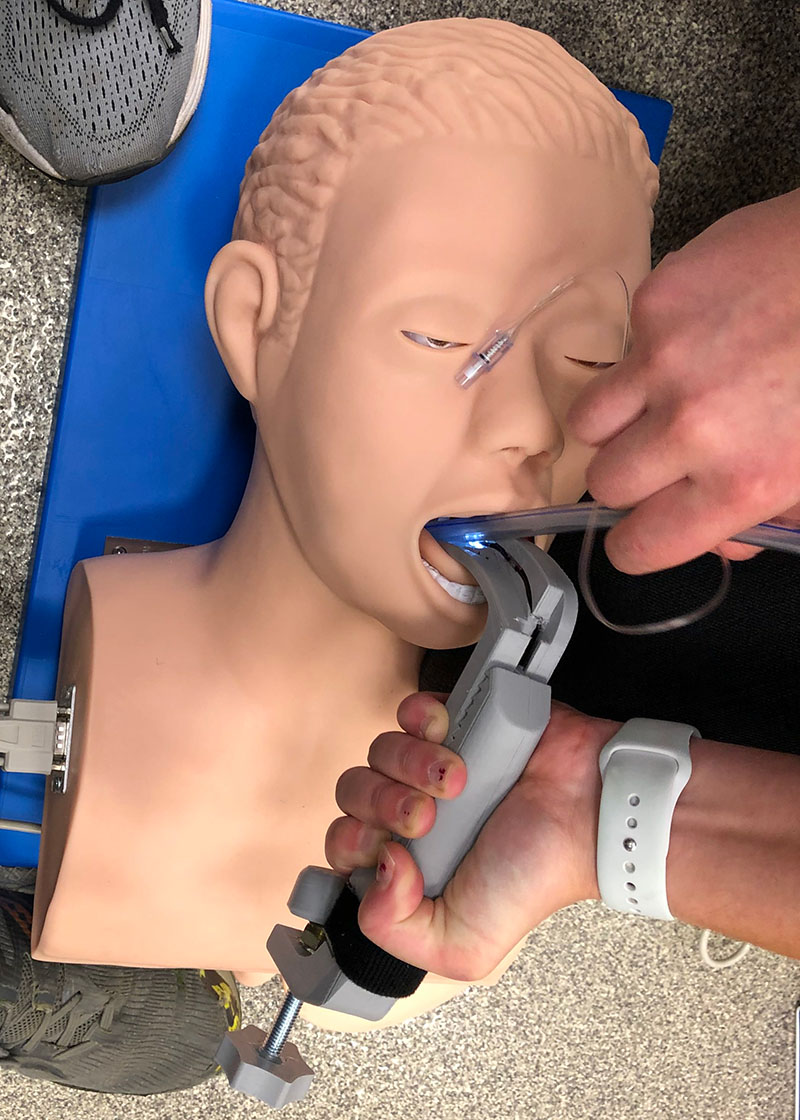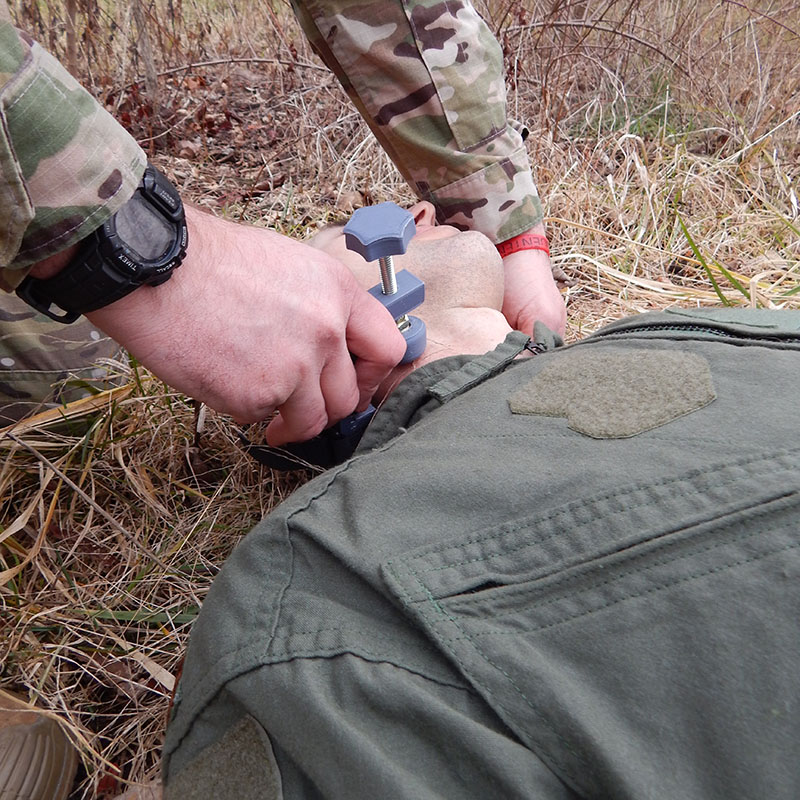The Life-saving Potential
ARC Device
Understand the New Device to Assist in Immediate Emergent Care for critical wounds.
History of the ARC
Injuries to the carotid artery of the neck are particularly common during combat, as it is in one of the few areas not protected by armor. Penetrating neck injuries also occur due to stab wounds and automobile accidents. The carotid is a vital artery that supplies blood to the brain, which requires a continuous supply of blood.
In the case that the carotid gets lacerated and begins to hemorrhage, the individual has minutes to live unless medical care is administered. The current protocol for this type of injury is to have somebody pinch the vessel to stop the bleeding, which requires constant attention from the medic, and prevents them from treating other injuries or other individuals that might need emergent care. Currently there are no occlusive devices on the market that target this critical region of the neck. This is a significant problem due to the high mortality rate of wounds to the carotid arteries and jugular veins that runs through this region.
The Arterial Restriction Clamp (ARC) device was developed to solve the problem of compressing the neck with an occlusive device to help provide stable hemostasis to the neck and facilitate transport. Additionally, the device helps sustain the maximal fighting in military operations. Lauren Edmonson, Austin Ballentine, Caleb Williams, and Dr. Tim Norman began the project and developed multiple prototypes. Dr. Jeff Williams was later added to the team to help fine-tune the device and drive clinical research.
As with any medical device looking to reach the marketplace, considerable testing is required. For a device designed to stop arterial blood flow, clinical studies are not possible. This is where the cadaveric perfusion model comes in. Drs. Norman and Williams assembled a team of investigators that could create a cadaveric perfusion model at Cedarville University.
The cadaveric profusion model (Fig. 1) is designed to provide simulated blood flow in a cadaver to allow for the testing of medical devices and surgical repair techniques that otherwise would not be possible due to the nature of the procedures.
In this model, synthetic blood is pumped from a reservoir into the femoral artery via a Medtronic BioMedicus 550 centrifugal pump. Synthetic blood flow rate and arterial and venous pressures are monitored to ensure near physiological pressure and flow conditions. Once the proper conditions are established in the cadaver, the carotid artery was 100% lacerated. In successive tests, the surrounding soft tissue was lacerated in increasing length and at each length, the ARC was tested for its effectiveness in tamponading blood flow. Testing outcomes were remarkable and proved the effectiveness for the ARC as a lifesaving device. The application of the ARC has the potential to make an almost unsurvivable injury treatable for military and civilian patients even in mass casualty situations. The device is patented.
The ARC was later re-designed to multi-purpose device by adding the functions of Laryngoscope for intubation in the field. Later, an insert and straps were added to provide additional functionality of junctional tamponade to apply pressure to junctional areas. This was recoined the Laryngoscope-Junctional ARC (LJ-ARC).
How the Arc Device Works
ARC Device Uses for Combat Injuries
LARYNGOSCOPE – ARTERIAL RESTRICTION CLAMP (L-ARC)
COMMON NAMES:
Neck Touniquet, Neck Vascular Clamp, LARC, L-ARC
BACKGROUND:
Injuries to the carotid artery are common during combat, as it lies in one of the few areas not protected by armor. The current protocol for this type of injury is to have the medic compress the vessel to stop bleeding; this requires constant attention and decreases mobility of the patient. The Arterial Restriction Clamp (ARC) (patent pending), has been developed to provide fast and effective arterial occlusion to zone 2 neck injuries. Currently, there are no occlusive devices on the market that target Neck Trauma Zone II. This was a problem due to the high mortality rate of wounds to the carotid arteries and jugular veins that coarse through this region. The brain has a redundant system of blood vessels called the Circle of Willis, which means that if one side is blocked, the other set of vessels continues supplying blood to the brain. The brain has a continuous supply of blood because of this, but if the other side is hemorrhaging, the individual doesn’t have much time to live, unless somebody pinches the carotid with their fingers. This eliminates the medic from the fighting force and subdues his ability to help anyone else. The ARC achieves 97.2% occlusion of Zone 2 of the neck.
Secondly, the Laryngoscope is an essential piece of equipment that is carried in the majority of advanced first responders (e.g., paramedics, pararescuemen, combat medics, etc.). The Laryngoscope function of the ARC (termed L-ARC) combines the utility of the ARC noted above with a commonly used laryngoscope function to help visualize the oropharynx for placement of a definitive airway such as an endotracheal tube (i.e. intubation).
INDICATIONS FOR USE:
Tourniquet (Vascular Clamp) – for penetrating neck wounds or enlarging hematoma without external bleeding, wherein prolonged lack of treatment could lead to serious bleeding, airway compromise, and/or neurologic damage.
Rigid Laryngoscope – for aid in helping to visualize the oropharynx to place a definitive airway (ex. endotracheal tube) during resuscitation of the unconscious patient.
ARC Device Uses for Hockey Injuries
Hockey is a high-speed and high-contact sport, which can result in a range of injuries, including cuts, bruises, fractures, and even internal injuries. The Arterial Restriction Clamp (ARC) and the Laryngoscope – Arterial Restriction Clamp (L-ARC), can be game-changing pieces of medical equipment in handling these injuries. Below are a few ways it could be used in a hockey context.
Neck and Head Injuries: In hockey, it is possible for players to suffer cuts or bruises to the neck or head from high-speed puck impacts, collisions, or accidental blade contacts. The ARC can be used to stop bleeding by applying pressure on the affected area. For larger head wounds, the ARC can be used to compress the injury or secure wound dressings, which can be crucial for injuries that result in significant bleeding.
Extremity Injuries: Hockey players often suffer injuries to their extremities like arms, legs, and ankles due to collisions or falls. The ARC can be used as an extremity tourniquet to stop bleeding in these situations. By securing a Cord to each end of the insert arm, the device can compress the area above the injury to control bleeding.
Abdominal or Truncal Injuries: In severe cases, a collision or a puck hitting the abdomen at a high speed can lead to internal injuries. The ARC device can be used for compression of the abdomen or lower trunk region. This can help in managing the injuries and controlling any internal bleeding until professional medical help arrives.
Thoracic Injuries: High-speed collisions can sometimes lead to injuries in the chest region. In such cases, the ARC can be used to apply compression to the chest, helping to control the bleeding and potentially preventing further damage.
In all these scenarios, the ARC’s ability to provide rapid, effective compression can be a potential lifesaver, reducing the risks of uncontrolled bleeding and allowing for quicker medical responses in the event of serious injury. It’s a versatile, multifunctional device that could play an essential role in first-response medical care in the high-intensity world of hockey.
INSTRUCTIONS FOR USE:
Neck Touniquet
When used with the insert (Fig 2), the device may be used to compress one side of the neck to stop bleeding or prevent hematoma formation. It is recommended that combat gauze be placed into an open wound before deployment of the device. Next, ensure that the insert (Fig 2) is seated upon the arm of the laryngoscope as seen in Fig 3. In addition, the ratcheting arm should be fully extended but not removed. Next, the hook-shaped portion of the device is placed around the back of the neck with the screw portion positioned directly over the site of injury. Next, the ratcheting arm is compressed to fixate the device upon the neck. Then, the screw is tightened until bleeding is controlled. Periodically and regularly deployment of device and after control of bleeding, the screw is loosened to check for breakthrough bleeding; if bleeding remains controlled after loosening of screw, the device is removed.
Laryngoscope
When used as a laryngoscope without the insert (Fig 1) the device may be used to visualize the oropharynx to place a definitive airway (e.g., endotracheal tube). The device is removed after visualization is complete.
Junctional device – Femoral Triangle (Groin)
An additional use of the ARC device is for junctional compression of the femoral triangle, otherwise known as the groin. To accomplish this, the insert arm piece (Fig. 2) of the device is first applied to the femoral triangle area of the patient with the convex side placed against the skin or clothing. Next, the insert piece is secured to the patient by attaching a piece of webbing, shoelace, cord, or other cord-like apparatus (hereto referred to as “Cord”) to each end of the insert arm, thereby making a tourniquet compression device. The Cord may be tightened to compress the area more. The Cord may be placed around legs or waist to further position or secure the ARC for this intended use. The ARC device may be used in conjunction with the insert piece for this intended use. The device or insert may be used in conjunction with or secured to rescue equipment, body armor, clothing, gear, or other accoutrement to further enhance positioning or securing of the device.
Junctional Device – Clavicular (lower neck)
An additional use of the ARC device is for junctional compression of the clavicular or sternoclavicular joint area of the lower neck, otherwise known as the collar bone. To accomplish this, the insert arm piece (Fig. 2) of the device is first applied to the clavicular or sternoclavicular joint area of the patient with the convex side placed against the skin or clothing. Next, the insert piece is secured to the patient by attaching a Cord to each end of the insert arm, thereby making a tourniquet compression device. The Cord may be tightened to compress the area more. The Cord may be placed around arms or chest to further position or secure the ARC for this intended use. The ARC device may be used in conjunction with the insert piece for this intended use. The device or insert may be used in conjunction with or secured to cervical collar, rescue equipment, body armor, clothing, gear, or other accoutrement to further enhance positioning or securing of the device.
Junctional Device – Axilla
An additional use of the ARC device is for junctional compression of the axillary area, otherwise known as the armpit. To accomplish this, the insert arm piece (Fig. 2) of the device is first applied to the axillary area of the patient with the convex side placed against the skin or clothing. Next, the insert piece is secured to the patient by attaching a Cord to each end of the insert arm, thereby making a tourniquet compression device. The Cord may be tightened to compress the area more. The Cord may be placed around arms or chest to further position or secure the ARC for this intended use. The ARC device may be used in conjunction with the insert piece for this intended use. The device or insert may be used in conjunction with or secured to rescue equipment, body armor, clothing, gear, or other accoutrement to further enhance positioning or securing of the device.
Large Defects of Neck
An additional use of the ARC device (Fig. 3) is for compression of large defects or wounds of the neck. To accomplish this, the ARC is readied in its routine compression configuration. Then, additional wound dressing (e.g., gauze, combat gauze, packing, ABD pad, clothing) is placed against the defect. The ARC is placed in its compression configuration against the patient and secured upon the aforementioned wound dressing, thereby acting as large wound dressing secure device. The ARC may be tightened or repositioned as per routine. Cord may be placed around arms or chest to further position or secure the ARC for this intended use. The ARC device may be used in conjunction with the insert piece for this intended use. The device or insert may be used in conjunction with or secured to cervical collar, rescue equipment, body armor, clothing, gear, or other accoutrement to further enhance positioning or securing of the device.
Abdominal or Truncal Compression
An additional use of the ARC device (Fig. 3) is for compression of the abdomen or lower trunk region. To accomplish this, the insert arm piece or the ARC device is applied to the area of the patient with the convex side placed against the skin or clothing. Next, the insert piece is secured to the patient by attaching a Cord to each end of the insert arm, thereby making a compression device. The Cord may be tightened to compress the area more. The Cord may be placed around legs or waist to further position or secure the ARC for this intended use. The device or insert may be used in conjunction with or secured to rescue equipment, body armor, clothing, gear, or other accoutrement to further enhance positioning or securing of the device.
Chest or Thoracic Compression
An additional use of the ARC device (Fig. 3) is for compression of the chest or thoracic region. To accomplish this, the insert arm piece or the ARC device is applied to the area of the patient with the convex side placed against the skin or clothing. Next, the insert piece is secured to the patient by attaching a Cord to each end of the insert arm, thereby making a compression device. The Cord may be tightened to compress the area more. The Cord may be placed around arms or chest to further position or secure the ARC for this intended use. The device or insert may be used in conjunction with or secured to rescue equipment, body armor, clothing, gear, or other accoutrement to further enhance positioning or securing of the device.
Extremity Tourniquet
An additional use of the ARC device (Fig. 3) is for compression of an extremity. To accomplish this, the insert arm piece of the device is first applied to the area of the extremity above the injury with the convex side placed against the skin or clothing. Next, the insert piece is secured to the patient by attaching a Cord to each end of the insert arm, thereby making a tourniquet compression device. The Cord may be tightened to compress the area more. The device or insert may be used in conjunction with or secured to rescue equipment, body armor, clothing, gear, or other accoutrement to further enhance positioning or securing of the device.
Head Wound Compression
An additional use of the ARC device (Fig. 3) is for compression of a head wound or to secure wound dressings. To accomplish this, the insert arm piece of the device is first applied to the area of the head above the injury with the convex or concave side placed against the scalp. Next, the piece is secured to a cervical collar, body armor, or other accoutrement by attaching a Cord to each end of the insert arm, thereby making a compression device. The Cord may be tightened to compress the area more.
CONDITIONS, PURPOSES FOR USE (e.g., hazards, warnings, precautions, contraindications):
Hazards: If subjected to high heat (greater than 140 degrees F), plastic on device may exume and cause skin corrosion/irritation. High heat may cause plastic to exume fumes which can be irritating. In the event of inhalation, move person to fresh air; if effects occur, consult a physician.
Precautions: The device should be kept in a dry place in its original packaging until ready to be deployed. The device should be discarded and not used if there are any signs of breakage in the mechanism. The Laryngoscope function of the L-ARC (Fig. 1) is intended to be used by individuals who are properly trained in placement of definitive airways and proper use of the device. The Arterial Restriction Clamp (ARC) (Fig. 3) is intended to be used by individuals who are properly trained in treatment of related injuries and proper use of the device.
Warnings: The Laryngoscope functional device should be removed immediately from the oropharynx after intended use and should not be left in the oropharynx unattended. The Laryngoscope is to be used on average sized necks and complications may occur if used on children or individuals with larger than average neck diameter.
The Arterial Restriction Clamp is intended to be used for the temporary control of neck hemorrhage or hematoma formation, and it should not delay transport of individual to the nearest facility that can provide more advanced care. The ARC should be slowly weaned and discontinued from the deployed position as soon as the situation permits or definitive care is reached.
Contraindications: The Laryngoscope device (Fig. 1) should not be used to remove foreign bodies from or when foreign bodies are present within the mouth or oropharynx. The Arterial Restriction Clamp (Fig. 3) should not be used when foreign body is present at the site of injury or in decapitation instances.
STUDIES:
Williams JS, Edmonson L, Ballentine AJ, Williams CT, Agoston J, Burns MK, and Norman TL, Carotid Arterial Occlusion utilizing a Cadaver Flow Simulation Model, Special Operations Medical Association (SOMA) Scientific Assembly, Charlotte, NC June 28-July 2, 2021.
Introduction: The ARC was designed to provide adequate pressure and coverage for blood occlusion in the most vulnerable region of the neck (Zone 2) but has been shown effective for all three zones. ARC design requirements included sizes to fit a variety of neck sizes, reversible, lightweight and compact. The device is low cost and 3D printable. The minimal design allows for visual confirmation of occlusion. The ARC has a quick time (seconds) and preapplication provides a mechanism for fine adjustment during transport.
Methods: Perfused cadaveric flow simulation model utilizing a 71-year-old male and an 81-year-old female was used. The cadavers were fresh and donors with a history of stroke and/or diabetes were excluded. The simulation models were based on previous work [1,2] The femoral vessels were cannulated and perfused with synthetic blood. Blood flow and arterial pressure were monitored to ensure near physiological parameters. The carotid artery and internal and external jugular veins were 100% lacerated in zone 2 of the neck. In multiple tests of each cadaver, the soft tissue was lacerated in increasing lengths: small (1.6 cm – 2.8 cm), medium (2.9 cm – 4.0 cm) and large (4.1 cm – 5.5cm). At each length, the ARC was tested for its effectiveness in tamponading blood flow. The percentage of, and time to, occlusion were recorded. Neck zones 1 and 3 were also tested.
Results: Occlusion rates were 100% in small lacerations in zone 1 and zone 2 and over 80% for nearly all locations and lacerations lengths. The exceptions are in zone 1. For large lacerations, packing the wound with gauze prior to ARC installation was efficacious. Average occlusion times were near 10 s for small lacerations in zone 1 and zone 2 and for a large laceration in zone 1. Occlusion times were under 30 s for all zones and lacerations lengths except for large lacerations in zone 3.
References:
[1] Carey et al, The American Journal of Surgery (2015) 210, 179-187.
[2] Russin et al., Operative Neurosurgery (2012) 71, 315-320.
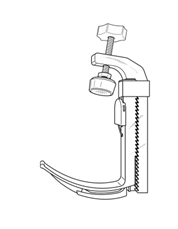
Fig.1 Laryngoscope
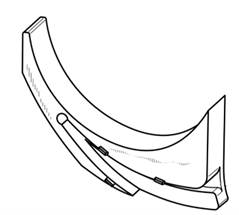
Fig.2 Insert
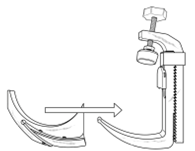
Fig.3 Arterial Restriction Clamp
Research
ARC Trauma, LLC has a unique team consisting of biomedical engineers, surgeon, paramedics, perfusionists, and people with military experience. This collaboration has allowed the team to perform studies on human cadavers to insure real-to-life testing of devices.
Presentations
Carotid Occlusion Using Arterial Restriction Clamp (ARC): Physician vs Emergency Medical Technician Effectiveness
Society for Academic Emergency Medicine Annual Meeting
May 11, 2022
New Orleans, LA
ARC Trauma, LLC presented research findings from their second cadaveric perfusion studies at the 2022 SAEM Annual Meeting. In this study, emphasis was placed on training EMT-B’s in the use of the device and then having them place the device.
PHOTOS TBD
“Carotid Occlusion Using Arterial Restriction Clamp (ARC)”
Special Operations Medical Association Scientific Assembly
May 24-28, 2021
Charlotte, NC
ARC Trauma, LLC presented research findings from their cadaveric perfusion studies at the 2020 SOMSA.
In the News
Cedarville University
Databytes Newsletter, October 28, 2020


